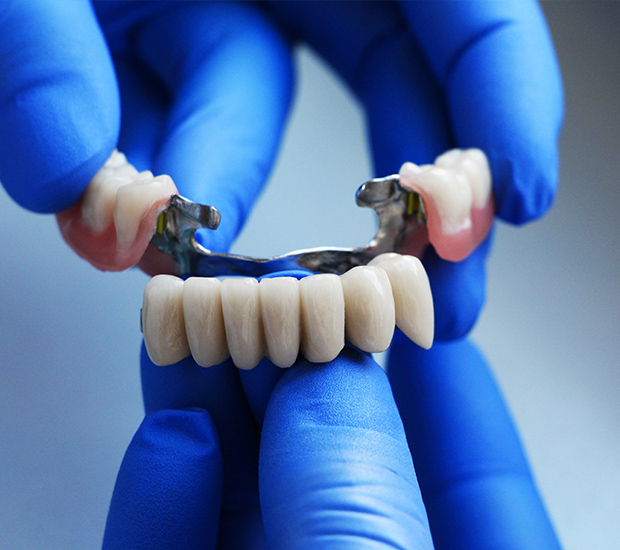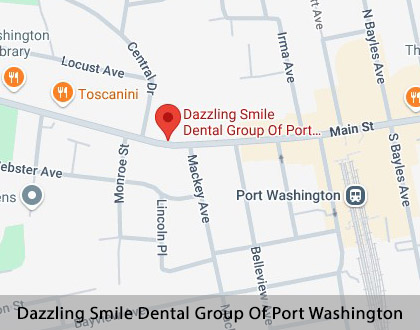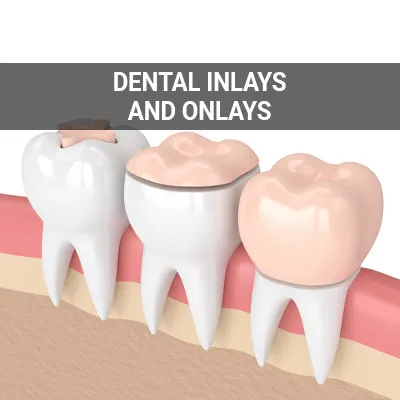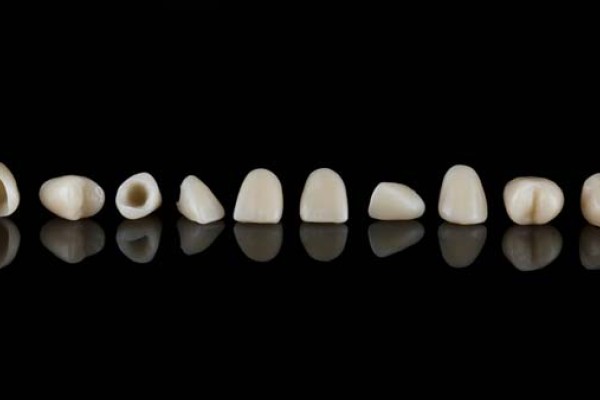Dental Bridges Port Washington, NY
Replacement teeth such as dental bridges help return the form and function of the mouth after a tooth extraction or other kind of tooth loss. Effective treatment and dental care after tooth loss can help patients enjoy more natural eating and speaking. A dental bridge is a type of replacement tooth that fills in the gap between natural teeth, often by connecting to the remaining teeth on either side of it.
Dental bridges are available at Dazzling Smile Dental Group Of Port Washington in Port Washington and the surrounding area. If you have missing teeth or are expecting to undergo an extraction, do not wait to address the problem. A dental bridge may not only restore the appearance of the smile but also make daily life more comfortable. Call (516) 301-1005 to schedule an appointment and learn more.
Understanding What a Dental Bridge Can Do for You
A dental bridge is a partial set of replacement teeth, usually made from porcelain that looks and feels like natural teeth. There are several types of dental bridges, but most connect to the abutting natural teeth to hold them in place. This helps prevent the rotating and shifting that can be brought on by gaps in the mouth left by missing teeth. Bridge work is typically designed to be a permanent addition to the mouth and is not removable. Dental bridges require healthy surrounding teeth or implants to have enough bone support.
With proper care, dental bridges can last for close to ten years. Dentists recommend patients brush and least twice daily using a soft-bristled toothbrush. It is important to floss daily around the teeth and bridge and use an antiseptic mouth rinse. Your dentist may recommend a proxabrush to clean under your bridge. Patients who have bridgework are also advised to avoid tobacco products and hard sticky items like caramel.
“A dental bridge is a partial set of replacement teeth, usually made from porcelain that looks and feels like natural teeth.”
Caring for and Adjusting to Dental Bridges
WebMD stresses the importance of good oral hygiene for keeping a dental bridge in good condition. It is crucial that patients keep up the recommended routine of brushing, flossing, and using mouthwash. The dental team will demonstrate the right technique for flossing around the crowns and bridge to prevent bacteria from flourishing there. It is also essential to see a dentist as soon as possible upon noticing any problems with the bridge. This can stop minor issues from snowballing.
Patients may experience minor discomfort the first few days after the placement of a dental bridge as they adjust. We recommend eating softer foods and avoiding sugary and acidic foods and beverages to keep them in good condition during the adjustment period. Over time, patients will become accustomed to the bridge and can resume normal diet and activities, following a strict hygiene routine.
“Continue the recommended routine of brushing, flossing, and using mouthwash.”
Dental Bridge Types
There are four major types of dental bridges. Three of them use different mechanisms to attach to the abutting teeth. The fourth type connects to the jawbone via an implant.
- Traditional. A traditional bridge is a combination of one or more replacement teeth with crowns on either side. It is necessary to grind down the abutment teeth slightly. The crowns are placed over the natural teeth and cemented in place.
- Cantilever. This is similar to a traditional bridge but used when there is only a single abutment tooth. It uses a cantilever design to secure the bridge in place from a single point.
- Maryland. The Maryland dental bridge also connects to the adjacent teeth. However, it has a metal framework that bonds to the inside of the natural teeth with resin, avoiding the need for crowns on the abutment teeth.
- Implant-Supported. Some bridges are implant-supported. They connect directly to the jawbone with dental implants, small metal studs that replicate natural tooth roots. Typically, there is one implant placed per replacement tooth.
“There are four major types of dental bridges.”
Check out what others are saying about our dental services on Yelp: Dental Bridges in Port Washington, NY
Dental Bridges Versus Dentures
One alternative to a dental bridge is a set of partial dentures. These can replace one or a few teeth similarly. However, unlike dental bridges, the dentures are not permanently placed but are removed for cleaning and sleeping.
Eating and speaking can feel more comfortable with dental bridges than with dentures, as dental bridges are more firmly rooted in place. Furthermore, you must remove dentures to clean them, whereas you can brush dental bridges like natural teeth. However, according to the American Dental Association, cleaning dental bridges may require extra care to ensure the health of the gum beneath the replacement teeth.
“Dental bridges are more firmly rooted in place than dentures, which can make eating and speaking easier.”
Questions Answered on This Page
Q. What are the different types of dental bridges?
Q. What are the differences between dental bridges and dentures?
Q. How does one maintain a dental bridge?
Q. What does getting a dental bridge entail?
People Also Ask
Q. How can a dentist replace missing teeth?
Q. What is restorative dentistry?
Q. When is a dental restoration necessary?
Q. Can dental bridges replace my missing teeth and restore my smile?
The Process of Getting a Dental Bridges
Receiving a bridge typically takes several appointments. If there are not already crowns on the abutting teeth, the dentist must shape them to prepare for crown placement. The dentist will also check the health of the gums and the abutting teeth. Any problems in these areas, such as decay or gum disease, will need to be addressed before placing the bridge. If implants are required to support the bridge, the process of placing them will need to happen first.
Our dentist will take impressions of the mouth and place a temporary bridge while a dental lab is preparing the permanent one. Several appointments may be necessary to finetune the fit of the bridge. We may attach it with temporary dental cement and avoid placing it permanently until we achieve the right fit.
“Our dentist will take impressions of the mouth and place a temporary bridge while a dental lab is preparing the permanent one.”
Frequently Asked Questions
Q. How is a dental bridge different from dentures?
A. Dentures require removal every day, while a bridge stays in the mouth permanently for the duration of its lifespan. On the one hand, bridges tend to offer a better fit and a more natural feeling. On the other hand, fitting the dentures does not require additional procedures such as a crown or implant placement.
Q. How long can I expect my dental bridge to last?
A. Dental bridges usually last between 10 and 15 years. Taking good care of the bridge and seeing a dentist on a regular basis can extend this period further.
Q. Is it normal to have tooth sensitivity after getting a dental bridge?
A. Tooth sensitivity is common after bridge placement. It usually goes away after a few weeks. In the meantime, it can help to avoid very hot or cold foods. The American Dental Association also recommends limiting acids, which can be in some types of mouthwash. Ask a dentist about alternative products.
Q. When do I need to see a dentist about problems with my dental bridge?
A. Some discomfort immediately after placement is usually normal; however, contact a dentist if pain or sensitivity persists or worsens. Damage to the bridge or crowns also needs prompt, professional attention.
Q. Why does my dental bridge keep coming loose?
A. If a dental bridge keeps loosening or falling out, the most common reason is decay in the supporting teeth. Other causes could include gum disease. Whatever the reason, a loose bridge is an important reason to call our office right away.
Dental Terminology
Helpful Related Links
- American Dental Association (ADA). Glossary of Dental Clinical Terms. 2025
- American Academy of Cosmetic Dentistry® (AACD). Home Page. 2025
- WebMD. WebMD’s Oral Care Guide. 2025
About our business, license, and website security
- Dazzling Smile Dental Group Of Port Washington was established in 2024.
- We accept the following payment methods: American Express, Cash, Check, Discover, MasterCard, and Visa
- We serve patients from the following counties: Nassau County
- We serve patients from the following cities: Port Washington, Manhasset, Roslyn, Great Neck, and Old Westbury
- NY (License #50348). View License Information and Specifics
- National Provider Identifier Database (1548388317). View NPI Registry Information
- Norton Safe Web. View Details
- Trend Micro Site Safety Center. View Details
Back to top of Dental Bridges











